New products at Crocus
by Sarah - November 19th, 2009.Filed under: Crocus, New Products.
New items today at Crocus
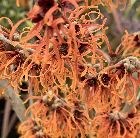
witch hazel £49.99
Position: full sun or partial shadeSoil: moderately fertile, moist, well-drained neutral to acid soilRate of growth: slow-growingFlowering period: January to FebruaryHardiness: fully hardyIn winter, this vase-shaped, deciduous shrub has clusters of sweetly scented, fiery orange flowers clinging to bare twigs. In autumn, the bright green leaves turn spectacular shades of yellow, orange and red. The tiered branches of this award-winning variety of witch hazel contrast well with the vertical stems of dogwood. A lovely specimen plant for a sunny winter border or woodland edge, where its perfume can be appreciated. The flowering twigs can be cut to perfume rooms in winter.Garden care: In early spring remove any misplaced, crossing or diseased branches and apply a generous 5-7cm (2-3in) mulch of well-rotted compost or manure around the base of the plant.
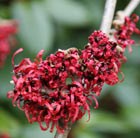
witch hazel £49.99
Position: full sun or partial shadeSoil: moderately fertile, moist, well-drained neutral to acid soilRate of growth: slow-growingFlowering period: January to FebruaryHardiness: fully hardyIn winter, this vase-shaped, deciduous shrub has clusters of sweetly scented, rich coppery-red flowers clinging to bare twigs. In autumn, the bright green leaves turn spectacular shades of yellow, orange and red. This award-winning variety of witch hazel is a lovely specimen plant for a sunny winter border or woodland edge. The flowering twigs can be cut to perfume rooms in winter.Garden care: In early spring remove any misplaced, crossing or diseased branches and apply a generous 5-7cm (2-3in) mulch of well-rotted compost or manure around the base of the plant.
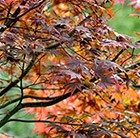
Japanese maple £49.99
Position: full sun (but not south-facing)Soil: fertile, moist, well-drained neutral to acid soilRate of growth: slow-growingFlowering period: April to MayHardiness: fully hardyAn elegant small tree, with deeply lobed dark purple-red leaves that turn fiery red in autumn, and tiny purple flowers in spring. This neat,slow-growing acer has an open habit, and looks dramatic silhouettednext to buildings, as a focal point in a small courtyard, or in aJapanese-style garden. It needs a sheltered spot, away from strongwinds or all-day sunshine. It also looks good in a container.Garden care: Add a top-dressing of a well-balanced fertiliser around the base of a recently planted tree in late spring and keep it well watered. No routine pruning is necessary. Remove any dead, damaged or crossing branches in April.
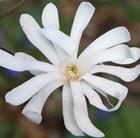
star magnolia £49.99
Position: full sun or partial shadeSoil: any moist, well-drained soilRate of growth: slow-growingFlowering period: March to AprilHardiness: fully hardyA popular, compact, bushy shrub or small tree with mid-green leaves and silky buds which open up to large, pure white, star-shaped flowers, sometimes faintly flushed pink. The flowers are lightly scented, and open very early, before the leaves, eventually covering the shrub for several weeks. This is one of the best magnolias for a small garden.Garden care: Plant in a sheltered spot, away from strong winds. Requires minimal pruning. Remove any broken, diseased or crossing branches after flowering. The best time to plant is in April, adding plenty of peat to the planting hole, in a sheltered spot. Mulch in spring with manure and leaf mould, especially on dry soils.
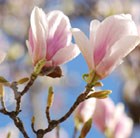
magnolia £49.99
Position: full sun or partial shadeSoil: moist, well-drained, acidic soilRate of growth: averageFlowering period: April to MayHardiness: fully hardyOne of the most popular magnolias, with large, dark green leaves that start to appear in mid spring, at about the same time as the huge, deep rose-pink or white, goblet-shaped flowers. This is a good magnolia for smaller gardens,as it remains a shapely shrub for many years, and even when it is mature, is a manageable small tree.Garden care: Requires minimal pruning. Remove any broken, diseased or crossing branches after flowering. The best time to plant is in April, adding plenty of peat to the planting hole, in a sheltered spot. Mulch in spring with manure and leafmould, especially on dry soils.

smoke bush £49.99
Position: full sunSoil: moderately-fertile, moist, well-drained soilRate of growth: average Flowering period: July to AugustHardiness: fully hardyThis deciduous shrub has magnificent, dark red-purple oval leaves, that turn scarlet in autumn. In July and August, it is festooned with fluffy plumes of purplish-pink flowers that look like a haze of smoke. This is an eye-catching specimen plant for a sunny shrub or mixed border. The foliage, which appears almost translucent when backlit by the sun, is at its best when the plant has been pruned hard in March.Garden care: In late winter or early spring remove any misplaced, diseased or crossing branches. Alternatively, to produce larger leaves, cut the stems back hard to within two or three buds of the base in early spring. After pruning apply a generous 5-7cm (2-3in) mulch of well-rotted garden compost or manure around the base of the plant.
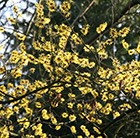
witch hazel £49.99
Spidery, yellow flowers cover the bare branches on this strong-growing witch hazel. The large blooms are extremely frost-resistant and highly fragrant, and appear from mid- to late winter. In autumn, the bright green leaves turn vibrant shades of orange and yellow. This is a lovely shrub for the woodland garden or as a specimen in the shrub border.Position: full sun or partial shadeSoil: fertile, moist but well-drained, acidic to neutral soilRate of growth: averageFlowering period: January to FebruaryFlower colour: yellowOther features: will also tolerate deep, humus-rich soil over chalkHardiness: fully hardy Garden care: Minimal pruning is required. Remove misplaced, dead or diseased branches in late spring and apply a generous 5-7cm (2-3in) mulch of well-rotted garden compost or manure around the base of the plantGoes well with: Magnolia x loebneri ‘Merrill’, Pyrus calleryana ‘Chanticleer’, Cornus mas, Syringa vulgaris ‘Charles Joy’, Garrya elliptica, Galanthus nivalis, Narcissus ‘Jenny’
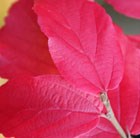
Persian ironwood £49.99
Position: full sun or partial shadeSoil: moist, well-drained soil, preferably acidicRate of growth: fast-growingFlowering period: January to FebruaryHardiness: fully hardyIn autumn, this deciduous tree is a breathtaking sight, as its large, smooth, wavy-edged leaves turn brilliant yellow, then orange and finally blaze fiery red before falling. In late winter and early spring, insignificant, spidery, red flowers appear before the leaves. Persion ironwood is a spreading tree, with a short trunk and peeling grey and fawn bark. As it normally has multiple stems, it is best grown as a large shrub in the border or in an open woodland garden. It can get very big, so it is best suited to larger gardens.Garden care: Requires minimal pruning. Remove any broken, diseased or crossing branches in late autumn or winter. When planting incorporate lots of well-rotted garden compost in the planting hole and stake firmly.
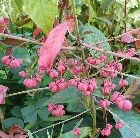
spindle tree £44.99
Position: full sunSoil: any well-drained soilRate of growth: averageFlowering period: May and JuneHardiness: fully hardyA large deciduous shrub, a native of European hedgerows, from which the wood was traditionally used for making spindles. This plant really comes into its own in autumn and winter, when its dark green leaves turn blazing scarlet. Insignificant summer flowers are followed by gorgeous, orange-pink, winged fruit which remain long after the leaves have fallen. Plant it in view of the house, where its vibrant display can be appreciated. It’s also wonderful in a winter border among early-flowering bulbs or shrubs grown for winter interest. The autumn colour is spectacular in full sun, but ‘Red Cascade’ will grow reasonably well in partial shade.Garden care: Tip prune young plants in mid to late spring to encourage bushy growth and apply a generous 5-7cm (2-3in) mulch of well-rotted garden compost or manure around the base of the plant.
magnolia £44.99
oleaster £39.99
Japanese Maple £39.99
Dogwood £39.99
enkianthus £39.99
Flowering Dogwood £39.99
Japanese snowball bush £39.99
oak-leaved hydrangea £34.99
sevenbark £34.99
dogwood £34.99






